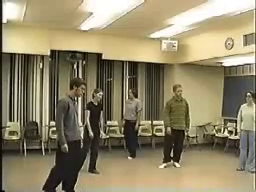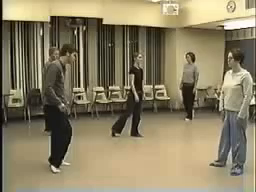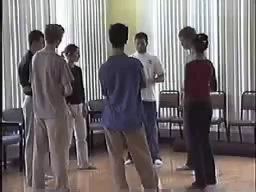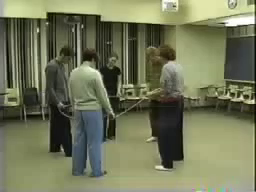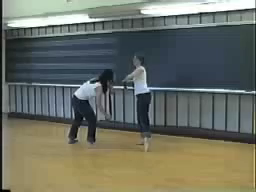Beyond Words: The Moving Body as a Tool for Musical Understanding
Diane J. Urista
KEYWORDS: Eurhythmics, body, movement, pedagogy, aural skills, kinesthesia
ABSTRACT: Instructors of aural skills traditionally rely upon singing and dictation, and intoning and tapping rhythms for teaching students. This study focuses on an approach that engages the moving body (drawn from Eurhythmics) to develop perception and the kinesthetic associations humans experience in the performance of music. I discuss seven video scenarios, each of which is designed to develop specific musical concepts and musicianship. This approach enhances the sensitivity of the students and the physical relationship with the music they perform and perceive. Furthermore, it refines their kinesthetic sense, strengthens musical memory, and the power of concentration.
Copyright © 2003 Society for Music Theory
[1] Introduction
“What the music I love expresses to me, is not thought too indefinite to be put into words, but, on the contrary, too definite.”(1)
[1.1] Musicians have long sought to develop more effective ways of teaching their craft. These efforts have traditionally found their most immediate expression, naturally, in words, though contrived melodies and dictation exercises are more recent manifestations of pedagogical tools. When one considers, however, the visceral, physical nature of music, it seems curious that current pedagogy places relatively little emphasis on nonverbal approaches to musical understanding. At the Oberlin Conservatory of Music, I have discovered that an embodied approach is more meaningful to students, because it affords them a direct link to the physical associations related to perception and performance.
[1.2] In my experience I have found it essential to engage the body, which helps
to promote skills that are vital to a competent musician. As David Lidov has
noted, there is a sense “of strong and intimate correspondences between the
details of music and bodily properties: gestures, tensions, and postures as well
as
[1.3] This article proposes that instructors at the college level consider a nonverbal approach—the moving body. I demonstrate and discuss the practical applications and advantages of using the moving body as a tool for learning, analyzing, and communicating music in the classroom, a tool that enhances kinesthetic awareness and music perception. Video performances from a first- and second-year conservatory classroom of the scenarios are presented to convey the benefits of moving-to-music. These scenarios are inspired by the work of Roger Graybill, Alexandra Pierce, and several Eurhythmics practitioners.(3)
[1.4] Although some people assume that Eurhythmics is for children, it is important to note that Dalcroze’s ideas were originally designed to improve learning for adults at the Conservatory of Music in Geneva, where he taught harmony and solfège. Eurhythmics is a music education approach that consists of three main parts: solfège, improvisation, and movement-to-music, which is the part that I will focus on. The main impetus behind Dalcroze’s approach grew out of his overall dissatisfaction with musical instruction at the Conservatory. He questioned why music theory was often taught only through abstractions divorced from sound, feeling, and motion. One of his primary goals was to heal what he perceived as the “mind-body split” in musical training and to promote an approach that stimulates, develops and refines all the capacities we use to engage in music: the aural, visual, tactile and muscular senses. He believed our physical movements were powerful referents for understanding musical rhythms, pitch, and motion. Many believe a connection exists between our aural impression of music and the kinesthetic sense, which many refer to as the “neglected” perception, or “sixth” sense. As Schnebly-Black and Moore explain, “Dalcroze teachers blend the aural perceptions of dynamics, beat, and pitches with muscular sensations of time, space, and energy. Out of this combination evolves a more subtle and expressive set of musical impulses and musical understanding. The addition of body movement to music training increases the amount of sensory information forming musical perceptions. When the whole body is used, the nervous system draws information from many networks: not just the hands, but the arms, shoulders, rib cage, and hips. The eyes, and ears, as well, join in a blending of sensory systems that reinforce each other in receiving and analyzing musical information.” I now discuss six musical scenarios, each of which is designed to teach a specific musical concept.(4)
[2] SCENARIO 1a: Exercise Designed to Teach Cadence
[2.1] The first scenario is a typical Eurhythmics exercise that fosters the recognition of cadences and explores the varying subtle shades of nuance among different kinds of cadences. Depending on available space, anywhere from five to twenty students can work comfortably. The students are placed randomly about the room, holding short wooden dowels. They are asked to move freely and to walk in time to the music that is played on the piano. When the final chord of the cadence has sounded, the students are to touch another person’s dowel with their own. The instructor plays musical exercises developed specifically for this purpose—four-bar phrases that end with different cadences: perfect and imperfect authentic, half, and deceptive. Video Clip 1 shows students who have performed the exercise and are acquainted with the music.
[2.2] As the movers become aware of the types of cadences, different physical gestures emerge that reflect the subtle qualities of the various cadences. For some types of cadences, the movers touch dowels gently and lightly above their heads; for other cadences they touch dowels swiftly and precisely near the waist. They also begin to exhibit facial expressions that mimic the cadences’ bold or tranquil character. A few movers physically represent the deflective effect of the deceptive cadence through the postural change of bending backward or to the side. Several movers join together at the end to represent the finality of the last perfect cadence.
[2.3] What takes place is a spontaneous, living analysis of phrase and cadence. Rather than passively talking about the idea of cadence before or after the music is heard, movers actively create a physical gesture with the cadence while it is being played—a personal response derived from the musical event itself that engages the kinesthetic sense. A traditional classroom setting typically involves the discussion and labeling of a musical concept. But as Eurhythmics teachers Moore and Schnebly-Black explain, “Eurhythmics focuses on the [physical] sensation itself, letting one moment develop into the next-seeking not identification but sensory continuity. Through Eurhythmics, people learn to use information fresh from sensation information fresh from sensation, before it has been consciously analyzed.”(5)
[2.4] Often times, during and after completing a physical activity such as the one just described, students ask questions about the kinds of cadences they have experienced, at which point we move to the board and begin traditional labeling. It is imperative that students experience first the sensations of a new musical idea, before identifying and analyzing it.
[2.5] I have noticed that students gain a deeper understanding of a concept by making their own physical representation of it and by seeing those of others. By “physical representation” I am suggesting a type of metaphor that is the body’s response to what is being perceived. When the association between aural perception and physical reaction meld, then the physical representation becomes an effective tool for realizing the subtle nuances of a passage. This interactive process heightens sensitivity and enhances the internalization of musical concepts. This is one of the reasons why moving-to-music is such a powerful learning tool. The aural, muscular, visual, and tactile senses are all engaged in the encoding of information. You may have noticed that some of the students are more adept than others at moving through space and representing the varying degrees of nuance among cadences. For instance, at the first cadence, one student did not anticipate the necessary time to meet with another person. Negotiating time and space, while listening to the conclusion of the phrase, is part of the skill required in this exercise. Some students were also late in responding to the cadence itself, and touched dowels immediately after rather than on the final chord. With a few simple suggestions, these kinds of problems are easily rectified and a student’s movement technique and accuracy improve quickly. I have found that enhanced movement technique equates to better musical perception, performance ability, and analytical insight.
[3] SCENARIO 1b: Cadence Exercise Converted into a Quick-Reaction Exercise
[3.1] Once the participants are comfortable with the four-bar groupings, the activity is converted into what Dalcroze calls a quick-reaction exercise. This happens by changing the music from a predictable pattern of four-bar phrases into an unpredictable mixture of two-, four-, and eight-bar phrases. The movers are now caught off guard. Some miss cadences when a two-bar phrase occurs instead of the expected four-bar phrase. Some movers accidentally touch dowels at the initiation of a phrase expansion, when they expect the conclusion of a prototypical four-bar phrase. In the following video, the students have practiced the exercise, but some are still surprised; others improvise gestures to represent what they hear. For example, some students mark the thwarted closure of a phrase extension by almost touching dowels at the point of a possible cadence and then pulling away when the extension begins (Video Clip 2).
[3.2] With any quick-reaction exercise, unpredictability is the key ingredient, for it is the element of uncertainty that forces students to remain alert; this, in turn, strengthens their power of concentration. In this particular exercise, students begin to realize that in order to represent the cadence at precisely the right time, they have to stay focused and listen intently for subtle cues within the music that signal whether the phrase is going to close or continue; otherwise they will fail to respond to the cadence. Quick-reaction exercises also train students to adapt mentally and to respond quickly and physically to change while retaining a sense of mental calm-a skill required of any musician. This is one of countless quick-reaction exercises that can be used to develop a sense of concentration and alertness.
[4] SCENARIO 2: Canon
[4.1] Now I will discuss another exercise, canon, which can be incorporated at any level in the aural skills classroom. In this exercise students move to a given rhythm or melody. As they are physically imitating that rhythm, another is played for them to imitate, and so forth. In Clip 3 you see a simple imitation exercise, where students are imitating one-bar melodic fragments. The imitation serves as a warm-up that is then converted into the canon, shown in Clip 4. (Play Video Clips 3 and 4 back-to-back.)
[4.2] The canon exercise is an excellent tool for developing musical memory. Students are engaged in a cycle of hearing, memorizing and physically executing one rhythm, while simultaneously committing the next one to memory. Canons also teach the art of performing one part while carefully listening to another, an essential skill for ensemble playing. The canon in this exercise is simple, featuring basic rhythms that are given one measure at a time. By increasing the rhythmic complexity and the number of bars in a segment, the difficulty of the exercise is increased. A canon can also be designed in such a way that the student experiences specific rhythms that play off of each other, for example, dotted or syncopated rhythms against straight rhythms.
[4.3] This canon can also be
realized in a more traditional manner by speaking (on the syllable “tah”) or by
clapping. As Graybill points out, however, whereas speaking teaches the correct
placement of attack points in a rhythm, it often lacks any musical expression or
dynamic inflection. He explains, “While [the] concept of rhythm as a neutral
series of attack points and durations may be appropriate in certain contexts, it
does not accord very well with our experience of rhythm in the fullest sense.
When we respond to rhythm as listeners or feel a rhythm as performers, we
experience something vital and dynamic-a flow of energy through time
[4.4] Graybill acknowledges the association of this dynamic aspect of rhythm with physical movement and refers to it as gestural rhythm, the fluidity of which is captured by movement. Moving the body through space allows the student to shape in expressive ways the musical spaces between and through beats. Musical spaces that are active and open to interpretation can be amplified and enlivened kinesthetically with straight and curved flow paths, changes in direction, varying degrees of energy, weight, speed, and postural balance-gestural qualities of rhythm that speaking or clapping would not as readily access.
[5] SCENARIO 3: Beat and Phrase
[5.1] The next exercise is designed to teach the organization of beat in phrase structure and compound meter. In this scenario, students standing in a circle pass a ball to one another at time points corresponding to the beats within a measure. One of the advantages of this exercise is that it physically illuminates and exaggerates what Dalcroze describes as the three main aspects of beat: the anacrusis, the physical preparation of the beat; the crusis, the precise point of contact; and finally the metacrusis, or afterbeat, the moment of rebound and follow-through resulting from the energy exerted from the crusis. In the video you will see students who have practiced the exercise and are comfortable with passing the ball. They are then directed to change direction when the phrase changes. By doing so, students have to listen carefully to both the beat and to the phrasing to execute the exercise successfully. (Play Video Clip 5.)
[5.2] Notice in the video that students made adjustments in timing and energy by slightly delaying the arrival of the cruses or by putting more or less weight in the cruses to represent the subtle changes in tempo and dynamic fluctuations. Notice also that the space between beats, that is, the anacrusis and metacrusis, becomes more enlivened and flexible when the tempo slows, allowing more latitude for interpretive flexibility. The movement involved in passing the ball magnifies the dynamic possibilities that exist between and through the articulation of beat.(7)
[6] SCENARIO 4: Schumann’s “Mondnacht” Musical Climax
[6.1] Our fourth scenario is designed to explore the dynamic
shape of phrase and musical climax in Schumann’s “Mondnacht” in E major from his
Liederkreis. Here the students focus on the dynamic shape of the vocal
phrases. They begin by learning the opening phrase (measures 6–13), which divides
into two subphrases. The first subphrase begins on the last beat of measure 6 and
peaks on the
[6.2] The physical tension of the rope is used to intensify the dynamic shape of phrase. The stretch of the rope allows students to feel through their muscles the qualities of elasticity, the sense of sustained momentum, and the dynamic sense of ebb and flow to and from the climactic points in the phrase.
[6.3] Some are obviously
more successful than others in representing
[6.4] In her work on climax and phrase
structure in Schumann’s “Mondnacht”, Alexandra Pierce experiments with several
movements to represent the climactic structure of phrase. Her account is
intriguing, because the visceral sensation she experiences from moving
contradicts the words typically used to describe phrase endings. One movement in
particular she describes is the “fountain,” which involves bringing her palms
together as the phrase starts (measure 6), lifting her hands up and outward over her
head at the moment of climax on the
[6.5] The “fountain” movement reveals a kinesthetic sensation of expansion that could not be represented through words alone. From Pierce’s account it is clear that another kind of intelligence was informing her: kinesthetic sensations and feelings overtly experienced through movement, remembered, and then later drawn upon covertly to enhance future listening and performing experiences. Through the continuous practice of moving-to-music, the participant draws into consciousness the intricate web of kinesthetic information that exists between bodily gesture and musical sound. The movement serves as a temporary exaggeration that highlights aspects of the musical structure.
[6.6] Typically in the classroom, students sing phrases and identify them by putting expressive markings in their scores. They may carefully follow these markings, but their performances often lack subtle nuance. Movement activities, such as the ones described here, invite students to investigate the infinite dynamic shadings that live behind the notes while they are learning and singing a piece. Musicality is not merely discussed or interjected as an afterthought; musicality is the main focus and purpose of the activity.
[7] SCENARIO 5: Form and Bartok’s “Song of the Harvest”
[7.1] The final scenario portrays a movement analysis of form to Bartok’s “Song of the Harvest” from his 44 Duos for 2 violins. (It will be beneficial for the reader to consult the score.) The piece consists of five sections. The first, marked lento, spans measures 1–5 and appears again in an inverted and transposed form at measure 16 and at measure 30. These sections are interrupted by two faster, canonic eruptions (marked parlando) that unfold from measures 6 to 15 and from measures 21 to 29. This is an example of a polished performance carefully worked out by two students with Eurhythmics experience. In this analysis, their moving bodies represent the duet of 2 violins. Note the way they negotiate the space of the room and interact with one another to represent the beginnings and endings of these five sections. (Play Video Clip 7.)
[7.2] In this rendition the students use a wringing gesture, which is facilitated by the stretch of nylon socks to amplify the tense dissonant nature of this Bartok piece. Their more sustained motion depicts the character of the softer lento sections; then they elapse into a series of abrupt torso bends to characterize the aggressive, angular contour of the two canonic sections.
[7.3] In a movement analysis such as this, instead of sketching out on paper the beginnings and endings of sections with letter names, labels, or arches, the movers instead mark these points with expressive physical gestures. Rather than talking about the form, which is traditionally done in a formal analysis, the participants’ bodies become the form.
[8] Conclusion
[8.1] Reflecting on Mendelssohn’s words quoted at the beginning of this article, I must admit that attempting to convey what it means to move-to-music by talking about it feels quite inadequate, that is, it feels so indefinite. Even so, I believe that the importance of using the body as a tool for musical understanding needs to be heard.
[8.2] By not using the body to learn about and analyze music, we may be denying ourselves the benefits of a dynamic tool that engages our kinesthetic sense, strengthens musical memory and our power of concentration, develops and stimulates the channels of communication between mind and body, refines physical coordination, and opens our ears to finer degrees of subtlety and nuance. Especially in a field where many of us as performers use our bodies to make music, we may be performing a disservice to our students and ourselves by not training both mind and body. Moving-to-music may not be for everyone, but if anyone remains skeptical about its virtues, it is important to remember that it is something that must be felt within the intimate space of the body to be understood, for the understanding comes with the experience of moving.(9)
Diane J. Urista
Oberlin College Conservatory of Music
Oberlin, Ohio 44074
diane.urista@oberlin.edu
Footnotes
1. Felix Mendelssohn in a letter to Marc-André
Souchay, Letters of Felix Mendelssohn-Bartholdy from 1833 to 1847, trans. Lady Wallace (London, 1864), 269–71.
Return to text
2. David Lidov, “Mind and Body in Music,” Semiotica 66, 1/3 (1987): 69–97.
Return to text
3. Roger Graybill, “Towards a Pedagogy of Gestural Rhythm,” Journal of Music Theory Pedagogy 4/1 (1990): 1–50; Alexandra Pierce, “Juncture,” In Theory Only 3/6 (1977): 23–24; Pierce, “Structure and Phrase (Part I),” In Theory Only 4/5 (1978): 22–35; Pierce, “Performance Phrase—Structure and Phrase (Part II),” In Theory Only 5/3 (1979): 3–24; Pierce, “Climax in Music—Structure and Phrase,” In Theory Only 7 (1983): 3–30. I am grateful to Eurhythmic practitioners Robert Abramson, Gabriella Chrisman, Herb Henke, and Stephen Moore for their ideas and inspiration. This article represents a pilot study, a first step in a book that I am planning that will elaborate more fully the background of this approach and will present a comprehensive curriculum for developing movement-to-music skills in colleges, universities, and conservatories.
Return to text
4. Julia Schnebly-Black and Stephen Moore, The Rhythm
Inside: Connecting Body, Mind and Spirit through Music (Oregon: Rudra Press,
1997), 43. Interested readers might also wish to consult the following sources
relating to embodied cognition, which address the connections between aural
perception and bodily movement: Arnie Cox, “The Mimetic Hypothesis and Embodied Musical Meaning,” Musicae Scientiae 5/2 (2002): 195–234; Ellen Dissanayake, Homo Aestheticus (New York: The Free Press, 1992); Marian T. Dura, Music Education and the Music Listening Experience (Queenston, Ontario: Edwin Mellen Press, 2002); Rudolph E. Radocy and David J. Boyle, Psychological Foundations of Music Behavior, 2d ed. (Springfield, IL: Charles C. Thomas Publishers, 1979); Alf Gabrielson, ed., Action and
Perception in Rhythm and Music (Stockholm: Royal Swedish Academy of Music,
1987); Neil McAngus Todd, “The Dynamics of Dynamics: A Model of Musical
Expression,” Journal of the Acoustical Society of America 91 no. 6
(1992): 3540–3550.
Return to text
5. Schnebly-Black and Moore, 44.
Return to text
6. Graybill, 1.
Return to text
7. his exercise also works very well for teaching
asymmetrical meter. I have successfully used this approach with Brubeck’s “Rondo Alla Turk” to teach the off-kilter feel of 2 + 2 + 3.
Return to text
8. Pierce, “Climax in Music—Structure and Phrase,” 14.
Return to text
9. I would like to thank the students at Oberlin
Conservatory for all their time and energies in participating in the
reenactments, and to my husband, Jonathan Niefeld, for shooting the videos. I
extend special thanks to Tom Lopez for his technical expertise in helping to
produce the videos, to Stephen Moore for allowing me to use the Bartok video
from his class, and to Allen Cadwallader for his editorial assistance.
Return to text
Copyright Statement
Copyright © 2003 by the Society for Music Theory. All rights reserved.
[1] Copyrights for individual items published in Music Theory Online (MTO) are held by their authors. Items appearing in MTO may be saved and stored in electronic or paper form, and may be shared among individuals for purposes of scholarly research or discussion, but may not be republished in any form, electronic or print, without prior, written permission from the author(s), and advance notification of the editors of MTO.
[2] Any redistributed form of items published in MTO must include the following information in a form appropriate to the medium in which the items are to appear:
This item appeared in Music Theory Online in [VOLUME #, ISSUE #] on [DAY/MONTH/YEAR]. It was authored by [FULL NAME, EMAIL ADDRESS], with whose written permission it is reprinted here.
[3] Libraries may archive issues of MTO in electronic or paper form for public access so long as each issue is stored in its entirety, and no access fee is charged. Exceptions to these requirements must be approved in writing by the editors of MTO, who will act in accordance with the decisions of the Society for Music Theory.
This document and all portions thereof are protected by U.S. and international copyright laws. Material contained herein may be copied and/or distributed for research purposes only.
Prepared by Brent Yorgason, Managing Editor and Tahirih Motazedian, Editorial Assistant



